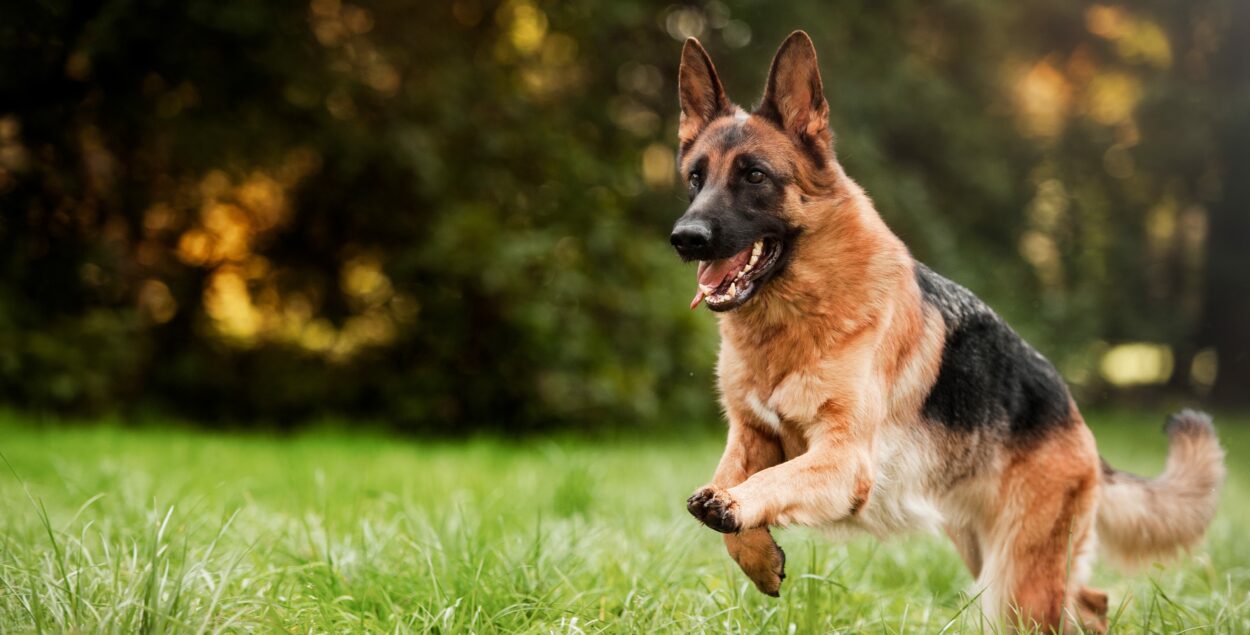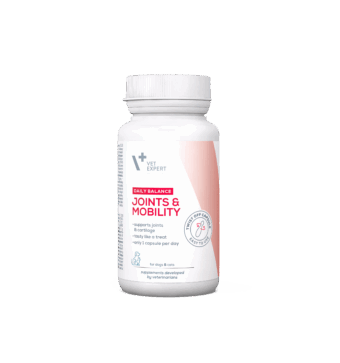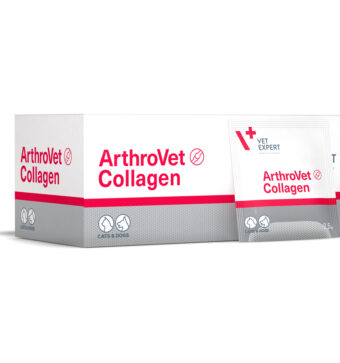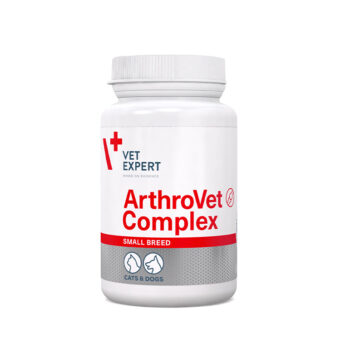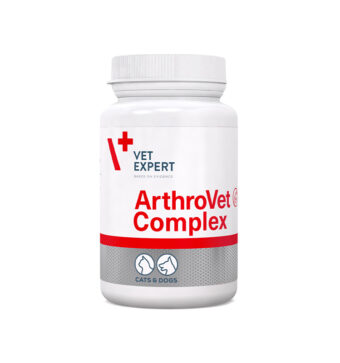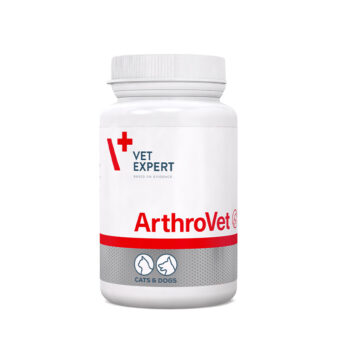Osteoarthritis (OA), commonly referred to Degenerative Joint Disease (DJD), is a chronic inflammatory disease of the joints. It is characteristic of older dogs and dogs of large and giant breeds. It is associated with chronic pain, limited physical activity and a reduction in their quality of life.
Why is taking care of a dog’s joints so important?
A dog that has healthy and nourished joints will have no problems moving or getting up from the den. Healthy joints affect the behavior and comfort of your pet, so it is worth taking care of them also prophylactically, without waiting for the first symptoms of the problem to show up.
How to care for your dog’s joints to avoid problems?
Dogs, which may be predisposed to joint diseases, certainly deserve special care.
To maintain healthy joints of a pet, three elements are crucial: proper regeneration of articular cartilage, an appropriate degree of joint flexibility and protection against injuries.
- Regeneration consists in supporting the production of collagen (the basic component of the structures of joints and tendons)
- Strengthening the joints means improving the flexibility of the articular cartilage, which protects it from damage
- The protective effect is possible thanks to the support of the proper functioning of the articular cartilage
When will you be sure your dog’s nutrient content is sufficient for the health and protection of your dog’s joints?
The first important element in caring for a dog’s joints is a properly balanced diet. Pay attention to the composition of the food you give your pet.
If you are not sure whether the feeding properly supplements your pet’s diet or if you feed your dog with a home diet, give them professional joint supplements, which will take care of the proper functioning of the pet’s musculoskeletal system.
What ingredients should be present in joint supplements for your pet?
- Chondroitin and glucosamine sulphate support the reconstruction of articular cartilage
- Hyaluronic acid facilitates the penetration of nutrients into the joint tissues; supports the action of chondroitin and glucosamine sulphate, improves joint flexibility
- Manganese, vitamin C support the production of collagen – the basic elements of the structures of joints and tendons
- Avocado and soybean extract helps reduce early degenerative changes in articular cartilage
- Harpagophytum procumbens (devil’s claw) extract reduces joint pain
Also, remember that maintaining healthy body weight is important for your dog’s healthy joints. Overweight or obese dogs are more likely to experience mobility problems caused by too much strain on the skeletal system and not getting enough exercise. That is why an important component of preparations supporting the joints is L-carnitine, which helps to maintain the correct bodyweight of animals.
Preparations that contain the above ingredients are, for example, Vet Expert ArthroVet products.
Do animals need exercise? They surely do. However, the level of physical activity must be adjusted to the age and health of your pet. Limit your dog’s vigorous activity during the growing period. In that case, for example, sudden jumps are not recommended, as they may negatively affect the skeletal system before the puppy finishes development. Also, in the case of older dogs, movement should be kept at a moderate level, without sudden joint strain.
For dogs at increased risk of joint disease, use joint protection prophylaxis by supplementing the animal’s diet with substances such as glucosamine and chondroitin, and many others.
What if the joint problem has already appeared?
However, if you notice disturbing symptoms in your pet, indicating problems with the locomotor system, a check-up visit with a veterinarian will be necessary. Based on the interview and examination, the doctor will be able to determine the cause of the pet’s discomfort and recommend appropriate action. It will be different in the event of an injury caused by overexertion and different when the dog develops osteoarthritis.
What exactly is canine joint degeneration?
It is a disease in which there is a loss of articular cartilage, remodelling of the bone structure and inflammation of the joint capsule and surrounding tissues. The loss of cartilage causes exposed bone surfaces to rub against each other as you move, which aggravates the joint lesions, causes severe pain and reduces your dog’s physical activity.
What could be the causes of joint degeneration?
The cause is not fully known, but the risk factors for osteoarthritis include:
- age (large breed dogs> 6 years old, medium and small dogs> 8-10 years old)
- genetic and breed predisposition (large breed dogs, e.g. German Shepherd)
- overweight and obesity
- too intense or too frequent workouts
- previous joint injuries
- other
How does osteoarthritis manifest in dogs?
If you notice one or more of the following symptoms in your dog that are symptoms of pain:
- problems with getting up and moving,
- lameness,
- licking paws, especially in inflamed areas,
- hypersensitivity to touch and irritability,
- decreased appetite and apathy,
consult your veterinarian.
Osteoarthritis in dogs – treatment
Osteoarthritis is a chronic and progressive disease in which, if changes do occur, they are irreversible. There is also no appropriate causal treatment. The therapy is based on the combination of anti-inflammatory and analgesic agents with preparations that protect the articular cartilage.
It is very important to maintain regular and relatively low body weight and exercise regularly, but only moderately. A good solution is to combine a diet with rehabilitation and to include supplementation that supports the proper functioning of articular cartilage.
Here, as in the case of prophylaxis, three elements are important: regeneration, flexibility, protection. An additional factor that is introduced in the event of degeneration of the joints is the analgesic and anti-inflammatory effect.
The preparation that will best support your dog’s joints has a regenerative effect – that is, supporting the production of collagen, which is the main component of the structures of joints and tendons.
It is also important to strengthen the joints – improving the elasticity of the articular cartilage, which will protect it from damage. Additional action limiting early degenerative changes and joint pain will definitely improve the animal’s comfort of movement.
Such a multifaceted therapy usually allows to limit the number of painkillers administered, slow down the progression of the disease and significantly improve the dog’s quality of life.
The best supplement for joints
When choosing the best preparation for joints, pay attention to their composition. Choose a product that has substances that regenerate, protect and strengthen the articular cartilage.
Features of a perfect joint preparation for your pet:
- Good products for the joints for dogs contain ingredients with scientifically proven effects, composed in such a way that they give the best effect together – pay attention to the comprehensive composition that best supports the functions of the joints (ensuring regeneration, flexibility, protection)
- Choose preparations that you can be sure have been developed by specialists who have knowledge and experience in animal nutrition – this is a guarantee of their quality and effectiveness
- It is important that the preparation is easy to administer and tasty – choosing one, you will be sure that your pet will accept it with pleasure
- It is trusted and readily recommended by veterinarians
An example of such preparation is ArthroVet products by Vet Expert.
Ask your veterinarian for the product that best supports your pet’s joints.
